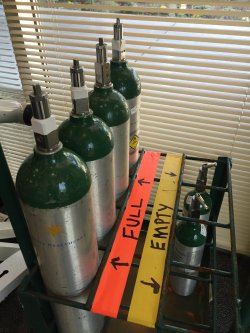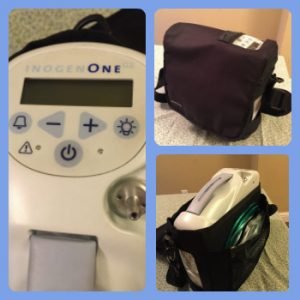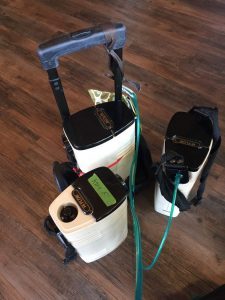This week, I’d like to pass on what I’ve learned about different types of portable oxygen possibilities to use away from home.
The suggestions I’m sharing are based on my own experience, and I realize they may be incomplete. I’d love to get your input on this topic! Please note that a doctor’s prescription is required for supplemental oxygen.
Gas cylinders
 You can safely use oxygen away from home via cylinders of compressed oxygen stored in steel and aluminum cylinders. The top of the cylinder has a place for a “regulator.” This is a device that regulates, or controls, the air flow coming from a O2 cylinder, usually between 1 and 15 liters per minute. Your oxygen provider will deliver the amount of “E” or “D” tanks, or cylinders, you need on a weekly or biweekly basis. The portable tanks must be replaced when empty. The “E” tanks are heavy, about 15 pounds, and most people push them around on a cart. Gas cylinders must be handled and stored carefully at home in a rack (see photo).
You can safely use oxygen away from home via cylinders of compressed oxygen stored in steel and aluminum cylinders. The top of the cylinder has a place for a “regulator.” This is a device that regulates, or controls, the air flow coming from a O2 cylinder, usually between 1 and 15 liters per minute. Your oxygen provider will deliver the amount of “E” or “D” tanks, or cylinders, you need on a weekly or biweekly basis. The portable tanks must be replaced when empty. The “E” tanks are heavy, about 15 pounds, and most people push them around on a cart. Gas cylinders must be handled and stored carefully at home in a rack (see photo).
Be very careful when transporting cylinders in your car. The Department of Transportation advises that they be stored uprightly with great care. Many cylinders contain pressures that are in excess of 2,000 pounds per square inch. A broken valve is all it takes for the cylinder to turn into an unguided missile.
No one explained to me the care necessary when transporting oxygen. When I first started using oxygen, I had an extra cylinder in my trunk secured to a heavy box. My husband and I went to visit our son, who just gotten his Ph.D. in physics. We opened the trunk and he saw it, and freaked. He said if the valve were broken in an accident, the tremendous pressure in the cylinder would have turned it into a missile and it would have plowed through the car and anyone or anything else in its way. He refused to get into the car until we moved it to the backseat, upright and secured to the seat with two bungee cords.
He asked me, “Have you ever noticed that O2 tanks in the hospital are chained to the wall?” I said, “Yes, I thought that was strange and wondered if they were afraid people would walk off with them.” He went on to say they were chained so that, in case a valve broke, the tank wouldn’t shoot through the room hurting people. Wow … not one doctor or oxygen provider ever explained this to me. Scary!
Portable Oxygen Concentrators
 There are several reliable portable oxygen concentrators (POCs) that allow you to leave your home to work, enjoy recreational activities, and travel. I won’t be covering all of them, but will share a few here. I am not endorsing any, but am sharing in part from my own experience.
There are several reliable portable oxygen concentrators (POCs) that allow you to leave your home to work, enjoy recreational activities, and travel. I won’t be covering all of them, but will share a few here. I am not endorsing any, but am sharing in part from my own experience.
There are two main types of POCs. Some provide a continuous flow of oxygen, and some deliver oxygen in a “pulse” — or puff of oxygen — as you breathe.
Continuous Flow Oxygen Concentrators
These portable units are able to produce up to 3 liters per minute of oxygen delivered continuously. Continuous flow is for those who need a small amount of oxygen when walking, or up to 3 lpm while sitting still or sleeping.
There are several types of continuous flow units available on the market (Sequal, Respironics, Devilbiss, and Oxlife, Inogen and Invacare). Most of these POCs deliver both continuous flow and pulse oxygen. I encourage you to research the different brands available. If you are planning to use your insurance rather than paying out-of-pocket, your insurance company will limit which models are available for you to choose from.
Pulse Dose Portable Oxygen Concentrators
These portable units deliver oxygen intermittently, and go as high as 6 lpm. Keep in mind that there is a difference between the lpm on a portable oxygen concentrator (POC) and a system that delivers oxygen continuously. The portable concentrators give a puff of air when you breathe, as opposed to oxygen being delivered continuously. That means 6 lpm on a POC is not as strong as 6 lpm being delivered via gas, liquid oxygen, or a continuous flow concentrator.
Please see the video below, where I demonstrate how this pulse machine works. These pulse dose machines run on AC, DC, and battery power. When I was using one of these machines I always made sure I had plenty of extra batteries with me and a cord to charge them. This is especially true when flying. These are the companies that I know of that make these pulse dose POCs: Airsep, Lifechoice, Inogen, Invacare and Sequel.
Liquid Oxygen
 As I mentioned in my last post, liquid oxygen is usually used by patients who need a higher flow of oxygen. Besides using liquid oxygen at home, patients can also use it away from home by using portable oxygen containers or “strollers.” These portable units are filled from the large liquid oxygen tanks that are delivered to your home. Please see the video below to see how my husband, Dave, fills them for me.
As I mentioned in my last post, liquid oxygen is usually used by patients who need a higher flow of oxygen. Besides using liquid oxygen at home, patients can also use it away from home by using portable oxygen containers or “strollers.” These portable units are filled from the large liquid oxygen tanks that are delivered to your home. Please see the video below to see how my husband, Dave, fills them for me.
Once I started using 7 liters per minute I found it much more difficult to go out and about. I was unable to physically carry the amount of gas cylinders I needed to go to the doctor and run errands, and my portable oxygen concentrator (Inogen G2) that went to a 6 pulse was no longer enough for me to use when walking.
By contrast, the liquid oxygen portable stroller was able to hold more oxygen than the gas cylinder and weighed half as much. Having two or three of them with me when going out solved my problem. I also have a smaller tank in my car. My oxygen company provides me with strollers by Caire that delivers liquid oxygen between ½ – 15 lpm. This system will last quite a while, even as my pulmonary fibrosis worsens.
I still keep my Inogen G2 portable oxygen concentrator in my trunk as an emergency backup just in case I get delayed or run out of liquid oxygen before I get home.
I’ve created a video to show you my Inogen G2 portable concentrator as well as my portable liquid O2, so you can see up close what the options are. I hope it is helpful to you.
I’d love to hear from you! What was helpful for you about this post or video? What other experiences using portable supplemental oxygen can you share with us?
Please share this post with anyone you feel could benefit, or on social media. We’re in this together.
***
Note: Lung Disease News is strictly a news and information website about the disease. It does not provide medical advice, diagnosis, or treatment. This content is not intended to be a substitute for professional medical advice, diagnosis, or treatment. Always seek the advice of your physician or other qualified health provider with any questions you may have regarding a medical condition. Never disregard professional medical advice or delay in seeking it because of something you have read on this website. The opinions expressed in this column are not those of Lung Disease News, or its parent company, BioNews Services, and are intended to spark discussion about issues pertaining to pulmonary fibrosis.

